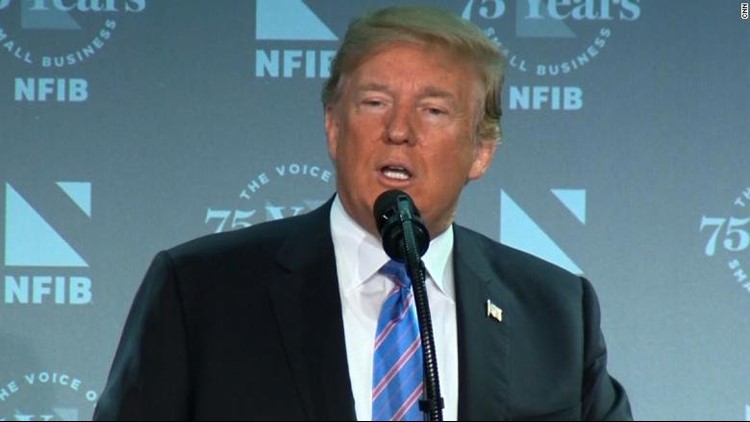WASHINGTON DC — President Trump is heading to Minnesota for a campaign rally right in the middle of a severe humanitarian crisis that is taking place on our borders.
The last time he appeared in the state was a few days before the election, when he railed against Syrian refugees who were pouring into the country. As children are now literally being torn from their families and sent into caged shelters, the President, almost like a comic book character, will likely use his time in the spotlight to rip into his world of villains — the news media, the MS-13 gangs, the special counsel’s investigators, and more — and give his adoring crowd exactly what they want to hear: Trump, Trump and more Trump.
Holding a massive barnstorming rally during this humanitarian crisis should not come as much of a surprise. Even though he is still new to politics, Trump is an electoral animal of the highest degree. He is constantly thinking about how to solidify his political support and has no compunction doing what is necessary to win.
With his opponents, his principle has been to hit them hard and hit with ten times the force of what he received. When the President is on the campaign trail, you can see him coming alive like a seasoned stage performer stepping through the curtain to begin a show.
President Trump views his hardline stance against undocumented immigration as being at the core of his electoral appeal. With critics blasting him from all sides, the President tweeted out that the Democrats “don’t care about crime and want illegal immigrants, no matter how bad they may be, to pour into and infest our country, like MS-13.”
His broader political objective is clear. With the 2020 election on his mind and, to a lesser extent, the 2018 midterms, President Trump feels confident that he can keep his 2016 coalition intact even if he can’t broaden his support. The Trump coalition is a mix of loyal Republicans who will bark about his conduct in the Oval Office but not bite (thus far, meaning most Republicans), the Trump fanatics who love their commander in chief no matter what he does and will do anything to help keep their anti-establishment, anti-hero in power, and the disaffected Democrats have looked to Trump as they feel that their status is threatened by long-term economic, social and cultural changes.
Taking a tough and forceful stand against undocumented immigration has been the core theme in Trump’s efforts to preserve his coalition. This is his version of backlash politics — the backlash on the border.
While the conservative backlash politics of the 1970s and 1980s revolved around race relations, Trump is the President who popularized the anti-immigration backlash within presidential politics. Bashing undocumented immigrants is the equivalent of Richard Nixon’s appeals to “law and order” after the urban riots of the 1960s or Ronald Reagan’s blasts against “welfare queens” or George H.W. Bush’s Willie Horton campaign advertisements. Now the focus has turned to people trying to enter our country without the proper documentation.
None of this is the creation of Donald Trump. He is just putting the ideas into effect like nobody else before him. The anti-immigration backlash has been growing within the GOP for decades, starting in the 1990s when California became ground zero for nativist forces who warned of the threat that undocumented immigrants posed to the republic.
Within the House of Representatives, opponents of liberal immigration policies kept growing in numbers during the early 2000s. Many Democrats have been tough on undocumented immigration as well, though never to the degree many Republicans have, and usually with the hope of a grand bargain. The rightward shift since the 1990s on this issue has been centered in the GOP.
During his second term, President George W. Bush found himself stifled by these members of his own party when they prevented him from achieving a grand bargain on the issue. In 2010, their numbers surged and President Obama had no chance of making legislative progress. In 2016, right-leaning voters elected a president who would finally carry out their polices and do so without any remorse.
These political calculations are the reason why President Trump has been so unwilling to back down from his policy of separating families. While most observers point to the overwhelming opposition that these policies are generating in the national polls, the President is most likely looking at polls such as the ones from Quinnipiac University and CNN that show most Republicans approving of the policy (55% to 35% in Quinnipiac and 58 to 34% in the CNN poll).
According to adviser Stephen Miller, one of the architects of the President’s policies (along with Attorney General Jeff Sessions), “You have one party that’s in favor of open borders, and you have one party that wants to secure the border. And all day long the American people are going to side with the party that wants to secure the border. And not by a little bit.”
These are the numbers that Trump continues to care about and they give him confidence to hold firm with his anti-family policy of separating parents from children until he can get the funding he wants for his wall. This is the same reason that President Trump was willing to get rid of the DACA program.
While it is of course possible that the Republican Congress ends up pressuring the President to end the policy of separating children at some point, Trump will still not desist in his ongoing attacks on immigrants. It’s going to remain a centerpiece of his political strategy and he likely won’t have any regrets about campaigning on it.



